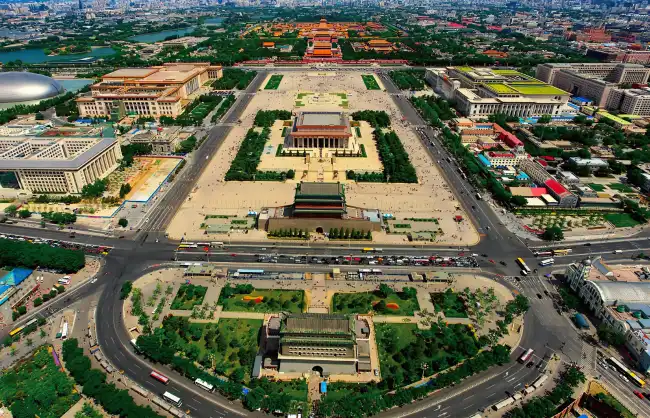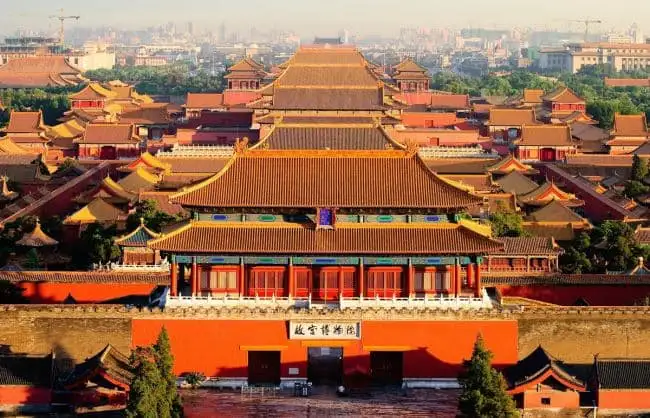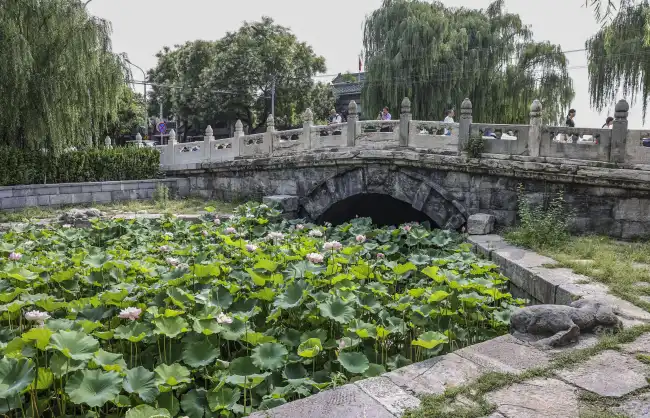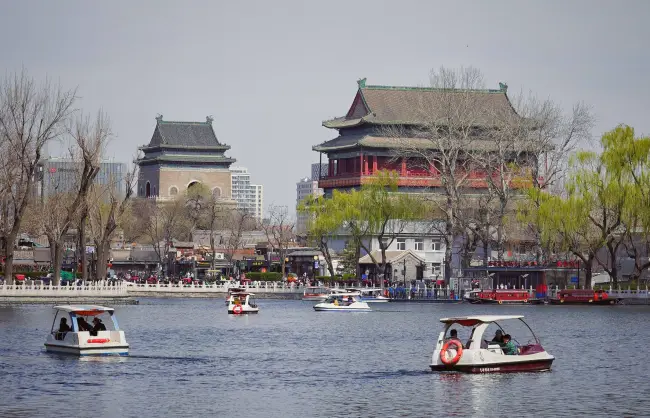Recently, Beijing Central Axis has been successfully listed as a World Cultural Heritage site, making this traditional capital’s central axis, which is the longest and the most complete existing in the world, once again the focus of public attention.
Beijing Central Axis runs from north to south through the heart of historical Beijing, spanning 7.8 kilometers from the Bell and Drum Towers in the north to the Yongdingmen Gate in the south. It is a combination of buildings and ruins that dominates the planning pattern of the entire old Beijing.
The central axis of Beijing was originated in the 13th century and formed in the 16th century. Since then, it has been continuously improved and has gone through more than 7 centuries, forming an urban architectural complex consisting of former imperial palaces and gardens, imperial sacrificial buildings, ancient city management facilities, national ceremonial and public buildings, and Central Axis road remains.
The location, layout, urban pattern, roads and design of Beijing Central Axis showcase the ideal capital city as prescribed in the Kaogongji, an ancient text known as the Book of Diverse Crafts. Architectural master Liang Sicheng once described it as follows: “The magnificent order unique to Beijing is created by the establishment of this central axis… With such a magnificent architectural layout and with such a scale to deal with space, there is no other in the world.”

Beijing Central Axis Facts
- Name:Beijing Central Axis: A Building Ensemble Exhibiting the Ideal Order of the Chinese Capital
- Chinese Name: 北京中轴线—中国理想都城秩序的杰作
- Location: Dongcheng District and Xicheng District, Beijing
- Era: Ming and Qing Dynasties
- Area:3 square kilometers, of which the heritage area covers 5.9 square kilometers and the buffer zone covers 45.42 square kilometers
- Protection Level: World Cultural Heritage by UNESCO
15 Landmarks of Beijing Central Axis
Beijing Central Axis has a grand scale, balanced and symmetrical planning pattern, and orderly urban landscape. It is classified as a “building complex” in terms of cultural heritage, consisting of 15 elements of heritage composition. You will be amazed by them during Beijing tours.
The key landmark buildings from south to north along Beijing Central Axis are:
Yongdingmen Gate
Facing Zhengyangmen Gate to the north. Firstly built in 1553, it was once the main gate of the outer city wall of the Ming Dynasty.
Altar of the God of Agriculture
Located in the southwest corner of the outer city of old Beijing, it has been in existence for over 400 years. The Beijing Museum of Ancient Architecture is right here.

Temple of Heaven
Located in the southeast of the outer city of the old Beijing, the Temple of Heaven covers an area of about 2.73 million square meters. It was built in 1420, and was a place for emperors to worship the heavens and pray for abundant harvests.
Southern Section Road Archaeological Sites
The important link connecting urban architectural complexes and public spaces. It was a necessary path for national ceremony activities in the Ming and Qing Dynasties.
Zhengyangmen Gate
Located at the southern end of Tian’anmen Square, and built in 1419. Commonly known as Qianmen, Zhengyangmen Gate was the south gate of the inner city of Beijing during the Ming and Qing Dynasties.

The Tian’anmen Square Complex
Located at the core of Beijing Central Axis. Formed in the Ming Dynasty and expanded in the mid-20th century, the Tian’anmen Square Complex includes the Monument to the People’s Heroes, Chairman Mao Memorial Hall, National Museum of China, and Great Hall of the People.
Outer Jinshui Bridges
Located over the Outer Jinshui River, it has always played an important ceremonial role. The layout of the bridge, the width of the bridge deck, the form of the column heads, and the decorative details all reflect the principle of “choosing the center”.
Tian’anmen Gate
Located in the center of Beijing, south of Upright Gate, and surrounded by the Outer Jinshui River to the south. Tian’anmen Gate was the place where imperial edicts were issued during the Ming and Qing Dynasties and major national events were held in modern times, witnessing the establishment of the People’s Republic of China.
>> Keep reading Top 15 Things to Do in Beijing
Upright Gate
Located between Tiananmen Gate and the Meridian Gate of the Forbidden City. It forms a leading sequence of ceremonial buildings for entering and exiting the palace during the Ming and Qing Dynasties, and is a part of the court space.
Altar of Land and Grain
Located in the southwest of the Forbidden City, it is symmetrically arranged east-west along the Beijing Central Axis with the Imperial Ancestral Temple. Built in 1420, it was originally a place where emperors worshiped the gods of land and grain.
Imperial Ancestral Temple
Located in the southeast of the Forbidden City, it is symmetrically arranged east-west along the Beijing Central Axis with the Altar of Land and Grain. Built in 1420, it was originally a temple for emperors to worship their ancestors.

Forbidden City
As the imperial palace during the Ming and Qing Dynasties, the Forbidden City is an outstanding example of royal palace architecture in China. The Palace Museum is a comprehensive museum in China.
>> Keep reading 10 Fun Facts About the Forbidden City
Jingshan Hill
Jingshan Hill is the commanding heights on the central axis of Beijing, located north of the Imperial Palace.

Wanning Bridge
Built in 1285, it is the starting point of the Grand Canal transport in the Yuan Dynasty and the only Yuan Dynasty bridge still serving social transportation in Beijing.

Bell and Drum Towers
Located at the northern end of Beijing Central Axis, they are important landscape viewpoints and were the timekeeping center of the capital city during the Yuan, Ming, and Qing Dynasties.
Welcome to embark your China tours to explore these beautiful heritage spots along Beijing Central Axis.

Beijing Central Axis Application for World Heritage
The application for World Heritage status of Beijing Central Axis took 12 years, starting in 2012. In order to protect the important cultural heritage of the central axis, Beijing has taken a series of measures, including planning and design, cultural relic repairs and relocation, and neighborhood renovation, and has also issued multiple related laws and regulations.
On January 30, 2023, the State Administration of Cultural Heritage officially submitted the declaration text to the UNESCO World Heritage Center.
On July 27, 2024, “Beijing Central Axis: A Building Ensemble Exhibiting the Ideal Order of the Chinese Capital” was listed as a World Heritage Site at the 46th session of the UNESCO World Heritage Committee held in New Delhi, India, becoming China’s 59th entry on that list.
The UNESCO World Heritage Committee recognizes that “Beijing Central Axis” meets World Heritage Criteria 3 and 4. The traditional Chinese urban planning theory and the philosophical ideas of “Center”(中) and “Harmony”(和) reflected in the Beijing Central Axis have made important contributions to the history of world urban planning (Criterion 3); As an outstanding example of the mature stage of the central axis of traditional Chinese capitals, Beijing Central Axis represents a unique type in the history of world cities (Criterion 4). Its integrity, authenticity, and protection and management status are also recognized.
Heritage experts said that Beijing Central Axis fills a gap in the World Heritage List regarding the ideal of urban landscape and the type of core architectural groups in the East, presenting an irreplaceable uniqueness and possessing outstanding universal value.









